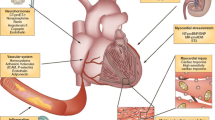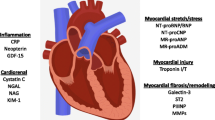Abstract
Little is known regarding objective predictors of cachexia affecting patients with heart failure (HF). We studied 108 stable chronic systolic HF patients with serial echocardiography and biomarker measurements over 10 months. Cachexia was defined as weight loss ≥5 % from baseline or final BMI <20 kg/m2; 18.5 % developed cachexia. While there were no significant differences in baseline or serial echocardiographic measures in those developing cachexia, we found significant differences in baseline amino-terminal pro-B type natriuretic peptide (NT-proBNP), highly sensitive troponin I, sST2, and endothelin-1. Baseline log NT-proBNP (hazard ratio (HR) = 2.57, p = 0.004) and edema (HR = 3.36, p = 0.04) were predictive of cachexia in an adjusted analysis. When serial measurement of biomarkers was considered, only percent time with NT-proBNP ≥1000 pg/mL was predictive of cachexia. Thus, a close association exists between baseline and serial measurement of NT-proBNP and HF cachexia.

Similar content being viewed by others
References
Januzzi, J. J. L., Rehman, S. U., Mohammed, A. A., Bhardwaj, A., Barajas, L., Barajas, J., et al. (2011). Use of amino-terminal Pro–B-type natriuretic peptide to guide outpatient therapy of patients with chronic left ventricular systolic dysfunction. Journal of the American College of Cardiology, 58(18), 1881–1889.
Evans, W. J., Morley, J. E., Argiles, J., Bales, C., Baracos, V., Guttridge, D., et al. (2008). Cachexia: a new definition. Clinical Nutrition, 27(6), 793–799.
Rossignol, P., Masson, S., Barlera, S., Girerd, N., Castelnovo, A., Zannad, F., et al. (2015). Loss in body weight is an independent prognostic factor for mortality in chronic heart failure: insights from the GISSI-HF and Val-HeFT trials. European Journal of Heart Failure, 17(4), 424–433.
Bayes-Genis, A., Lloyd-Jones, D. M., van Kimmenade, R. R., Lainchbury, J. G., Richards, A. M., Ordonez-Llanos, J., et al. (2007). Effect of body mass index on diagnostic and prognostic usefulness of amino-terminal pro-brain natriuretic peptide in patients with acute dyspnea. Archives of Internal Medicine, 167(4), 400–407.
Kalra, P. R., & Tigas, S. (2002). Regulation of lipolysis: natriuretic peptides and the development of cachexia. International Journal of Cardiology, 85(1), 125–132.
Sarzani, R., Dessi-Fulgheri, P., Paci, V. M., Espinosa, E., & Rappelli, A. (1996). Expression of natriuretic peptide receptors in human adipose and other tissues. Journal of Endocrinological Investigation, 19(9), 581–585.
Sengenes, C., Berlan, M., De Glisezinski, I., Lafontan, M., & Galitzky, J. (2000). Natriuretic peptides: a new lipolytic pathway in human adipocytes. FASEB Journal, 14(10), 1345–1351.
Galitzky, J., Sengenes, C., Thalamas, C., Marques, M. A., Senard, J. M., Lafontan, M., et al. (2001). The lipid-mobilizing effect of atrial natriuretic peptide is unrelated to sympathetic nervous system activation or obesity in young men. The Journal of Lipid Research, 42(4), 536–544.
Author information
Authors and Affiliations
Corresponding author
Ethics declarations
Funding
Assays for IL-6, VEGF, and TNF-α were performed by Singulex, Inc. The sponsor had no role in design, data collection, analysis, manuscript preparation, interpretation, or decision to submit the manuscript for publication. Dr. Ibrahim is supported by the Dennis and Marilyn Barry Cardiology Fellowship. Dr. Gaggin is supported in part by the Ruth and James Clark Fund for Cardiac Research Innovation, and Dr. Januzzi is supported in part by the Hutter Family Professorship in Cardiology.
Conflict of Interest
Dr. Gaggin reports the following disclosures: (1) Roche Diagnostics: research grant, consultancy; (2) Portola: research grant; (3) Amgen: consultancy; (4) American Regent: consultancy; (5) Boston Heart Diagnostics: consultancy; (6) Critical Diagnostics: consultancy; and (7) EchoSense: clinical endpoint committee. Dr. Januzzi reports the following disclosures: (1) Roche Diagnostics: research grants, consultancy; (2) Siemens Diagnostics: research grants; (3) Prevencio: research grants; (4) Singulex: research grants; (5) Critical Diagnostics: consultancy; (6) Sphingotec: consultancy; (7) Philips: consultancy; (8) Cardiorentis: consultancy; (9) Novartis: clinical endpoints committee, consultancy; (10) Boeringer-Ingelheim: clinical endpoints committee, consultancy; and (11) Amgen: data monitoring committee. None of the other authors has disclosures.
Ethical Approval
All procedures performed in studies involving human participants were in accordance with the ethical standards of the institutional and/or national research committee and with the 1964 Helsinki declaration and its later amendments or comparable ethical standards.
Informed Consent
Informed consent was obtained from all individual participants included in the study.
Additional information
Associate Editor Daniel P. Judge oversaw the review of this article
Clinical Relevance
• While little is known regarding predictors of cachexia in heart failure patients, evaluation of serial echocardiography as well as novel and established biomarkers provided intriguing insight into the pathophysiology of cachexia in heart failure.
• Cachexia was common in heart failure patients with reduced ejection fraction and appeared to be closely associated with both baseline as well as serial measurement of amino-terminal pro-B type natriuretic peptide (NT-proBNP).
Rights and permissions
About this article
Cite this article
Gaggin, H.K., Belcher, A.M., Gandhi, P.U. et al. Serial Echocardiographic Characteristics, Novel Biomarkers and Cachexia Development in Patients with Stable Chronic Heart Failure. J. of Cardiovasc. Trans. Res. 9, 429–431 (2016). https://doi.org/10.1007/s12265-016-9710-4
Received:
Accepted:
Published:
Issue Date:
DOI: https://doi.org/10.1007/s12265-016-9710-4




